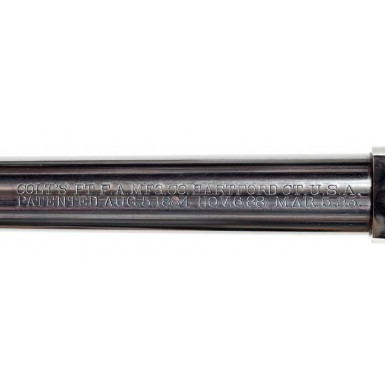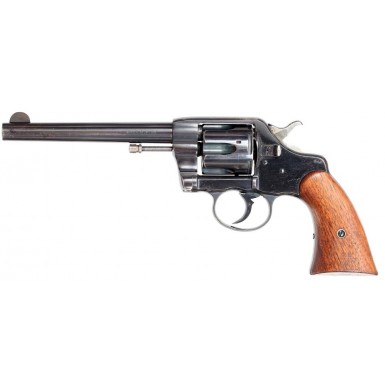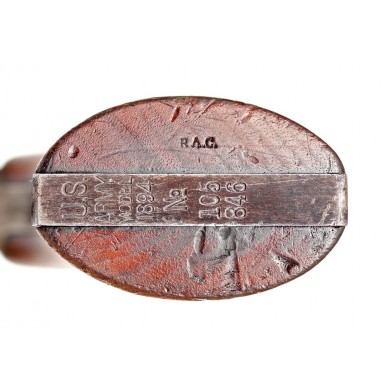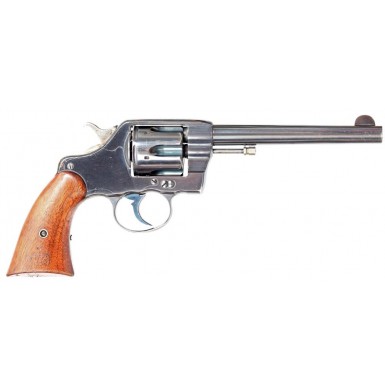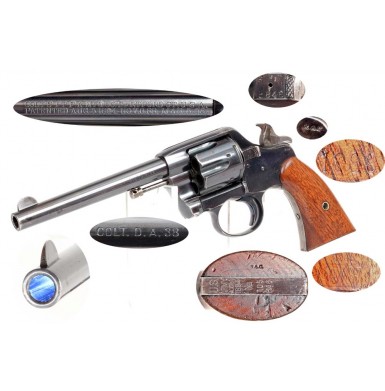Colt New Army & Navy M-1894 Revolver - Excellent
- Product Code: FHG-1696-SOLD
- Availability: Out Of Stock
-
$1.00
In 1889 Colt revolutionized their revolver product line by introducing their first swing-out cylinder revolver, the M-1889 Navy Double Action Revolver. All previous large frame Colt revolvers had been built with a loading gate to access the chambers of the cylinder for loading and unloading. While the design was very strong due to the solid frame and top strap, it was very slow to load and unload. Colt’s primary competition for large frame revolvers came from Smith & Wesson. While the Smith & Wesson top-break revolvers offered automatic extraction and quick reloading, they did not have the strength of the Colt designs. Thus customers had the choice of the stronger Colt design (and the more powerful .45 Colt cartridge) with slower loading and reloading, or a slightly weaker design that offered much faster loading and reloading, but did not offer .45 Colt chambering. The M-1889 changed everything, as the swing out cylinder and manual ejector system offered the speed of the Smith & Wesson, but retained the solid frame design of the earlier Colt’s for strength. The US Navy obtained some 5,000 of the M-1889 revolvers. Although nearly all of the revolvers were eventually modified by Colt to include a more secure cylinder locking system, the revolvers performed well enough for the US Army to look at abandoning its 20+ year old Single Action Army revolvers and adopt a modern, double action service revolver. The first model adopted by the Army was the M-1892 New Army & Navy Revolver, and over then next decade thousands of the new double action revolvers would be acquired by the US military, with model designations of M-1892, M-1894, M-1895, M-1896, M-1901 and M-1903. The differences between the various models were almost impossible to observe from the exterior of the revolver, as the improvements centered on the lock work and cylinder locking system. The only significant external indications of differences were the addition of new patent dates on the barrel as improvements were incorporated, and the model designation stamped in the butt of the revolver. All of the Army procured revolvers had the same basic features. They were double action revolvers with 6-shot swing-out cylinders and 6” tapered round barrels. The guns were blued and the military contract arms had oil finished walnut grips. While Colt offered the M-1892 family of revolvers in both .41 Long Colt and .38 Long Colt, only the .38 Colt chambered revolvers were procured by the military. The .38 Long Colt was an inferior cartridge when compared to the other large frame revolver cartridges of the day. It fired a 150-grain lead round nosed bullet with a .361” diameter at about 770 feet/second, resulting in muzzle energy of about 200 ft-lbs. By contrast, the .45 Colt cartridge that was being replaced by the new cartridge had produced around 450 ft-lbs of muzzle energy by firing a nominally 250 grain lead round nosed bullet at around 800 ft/s. That was more than twice the power of the new .38 Colt. The old .45 Colt was nearly identical ballistically to the .45ACP which would eventually become the standard US military handgun cartridge with the adoption of the M-1911 semi-automatic pistol. The .38 Long Colt was instrumental in the re-adoption of the large bore .45 caliber service handgun, due to numerous “failures to stop” in the field. The M-1892 New Army & Navy family of revolvers were the standard US military handguns for the US Military from 1892 through 1909, when the US military returned to a .45 handgun with the double action Colt New Service M-1909 revolver. The M-1892 New Army & Navy Revolver was the standard US military handgun for the Spanish American War of 1898 and the Philippines Insurrection (the Philippine-American War) from 1899-1902. It was during the war in the Philippines that the stopping power of the .38 Long Colt was seriously questioned. A number of recorded instances exist where multiple hits with .38 Colt bullets failed to stop charging Pilipino warriors. This became an even more serious problem during the Moro Rebellion in the Philippines, where raging Moro tribesmen, fortified with various natural herbs and intoxicants, were seemingly immune to numerous hits from the puny cartridge. The result was the emergency re-issue of old Colt M-1873 Single Action Army revolvers, with their man-stopping .45 Colt cartridges. When the .45 Colt, double action Colt M-1909 New Service was officially adopted the M-1892 family of handguns were relegated to secondary service, and with the adoption of the M-1911 Pistol, they were eventually removed from service. However, the double action, .38 caliber revolver with the swing out cylinder was now entrenched enough in US military service that revolvers would continue to see issue and use on a limited, emergency and secondary basis. Although the .38 Long Colt was soon supplanted by the more powerful .38 Special cartridge, the Colt revolvers had revolutionized the way that the military looked at the service revolver.
This example of a Colt M-1894 New Army & Navy Revolver is in EXCELLENT condition. The gun is well marked throughout showing clear military inspection cartouches, sub-inspection marks and an 1898 acceptance date. The revolver is serial numbered 105,846 on the butt, placing production in second part of 1898. Most references note that all Colt New Army & Navy Revolvers with serial numbers under 115,000 are antique and were manufactured prior to December 31, 1898. This exempts them from Federal Firearms laws, as they are officially antique and not considered firearms by the US government. The top of the barrel of the revolver is clearly marked in two lines: COLT’s PT F.A. MFG. CO. HARTFORD CT. U.S.A. / PATENTED AUG. 5, 1884 NOV. 6, 88. MAR. 5, 95.. The left side of the barrel is clearly marked with the caliber of the revolver, COLT. D.A. 38. The bottom of revolver’s butt is crisply marked in seven lines: U.S. / ARMY / MODEL / 1894 / No / 105 / 846. The cylinder release is marked K over the number 5846, which is the last 4 digits of the serial number. The last four digits of the serial number also appear on the inside of the frame where it meets the crane, and on the crane itself. Both grips bear the pencil number 5846 on their interiors as well. The upper left rear of the frame bears the initials of US Ordnance Sub-Inspector Rinaldo A. Carr, and is crisply stamped R.A.C.. Carr inspected a wide variety of US small arms, including Colt M-1873 Single Action Army revolvers and Colt M-1892 series revolvers, working in that capacity from 1889 to 1909. His inspection initials are also present on the rear of the cylinder and the bottom of right grip panel. The right grip panel also bears Carr’s script RAC inspection cartouche. The left grip panel is marked with the acceptance date 1898 over the script DMT acceptance cartouche of Ordnance Department Captain Daniel M. Taylor. As noted previously, the revolver is in EXCELLENT condition overall. The revolver retains about 90%+ of its original Colt factory blued finish, with only some very minor wear and fading noted. The most noticeable area of finish loss is along the backstrap and butt of the revolver, where the blue has faded and worn from handling, and has blended with a smooth plum-brown patina. There is also some very minor fading and loss along the high edges and contact points, and around the muzzle, as well as some very lightly scattered oxidized freckling here and there. The finish on the revolver also shows some minor surface scuffing from handling and holstering over the last 100 years. The trigger and hammer are niter blued, with the sides of the hammer polished bright. Both retain the large majority of their bright blued finish, which shows some fading and some purplish tones. The bright sides of the hammer showing some minor, oxidized, age discoloration. The ejector rod is also polished bright and remains mostly bright and shiny. The revolver is mechanically excellent and the action functions perfectly. The cylinder rotates, times, indexes, and locks up exactly as it should. The cylinder swings free smoothly and the cylinder locking catch functions perfectly. It releases crisply and latches securely, exactly as it should. The bore of the revolver rates about EXCELLET as well, and the bore is bright and shiny with very crisp and sharp rifling. There is only some very minor pinpricking scattered in the grooves of the rifling. The screws all retain the majority of their fire-blued finish, and have crisp, unmolested heads with minimal slot wear. The two-piece oiled walnut grips rate about EXCELLENT as well. They are solid and complete and free of any breaks, cracks, chips or repairs. As would be expected they show some minor handling marks and light dings from service and use, but absolutely no abuse or damage. The grips both retain fine, crisp and clear cartouches. The left grip shows a crisp 1898 / DMT cartouche and the right one shows a clear RAC. The bottom of the right grip shows an equally crisp R.AC. sub-inspection mark.
Overall this is a really EXCELLENT condition example of a Colt M-1894 New Army & Navy revolver. The gun retains nearly all of its finish, and shows only the most minor finish loss due to handling and light use. The gun shows just enough wear to know that it was issued, and did not spend its life in an armory never having seen the field at all. The gun is mechanically perfect and really stunning to look at. It would be very difficult to upgrade this revolver. It would be a wonderful addition to any serious collection of US Military revolvers or handguns, and is a great example of one of the first, reduced caliber modern handguns to see US service. This would also be a fantastic addition to any display centering on the Spanish-American War or the Philippines Insurrection.
On a point of safety, this revolver would also be a wonderful shooter. However, it is designed only for use with black powder loaded .38 Long Colt cartridges and not for use with modern, smokeless cartridges. Due to the fact that chambers of these revolvers are straight walled and not tapered, .38 Special (and sometimes .357 Magnum) ammunition will often chamber in these revolvers. However, neither cartridge is ever safe to shoot in these guns.
SOLD

